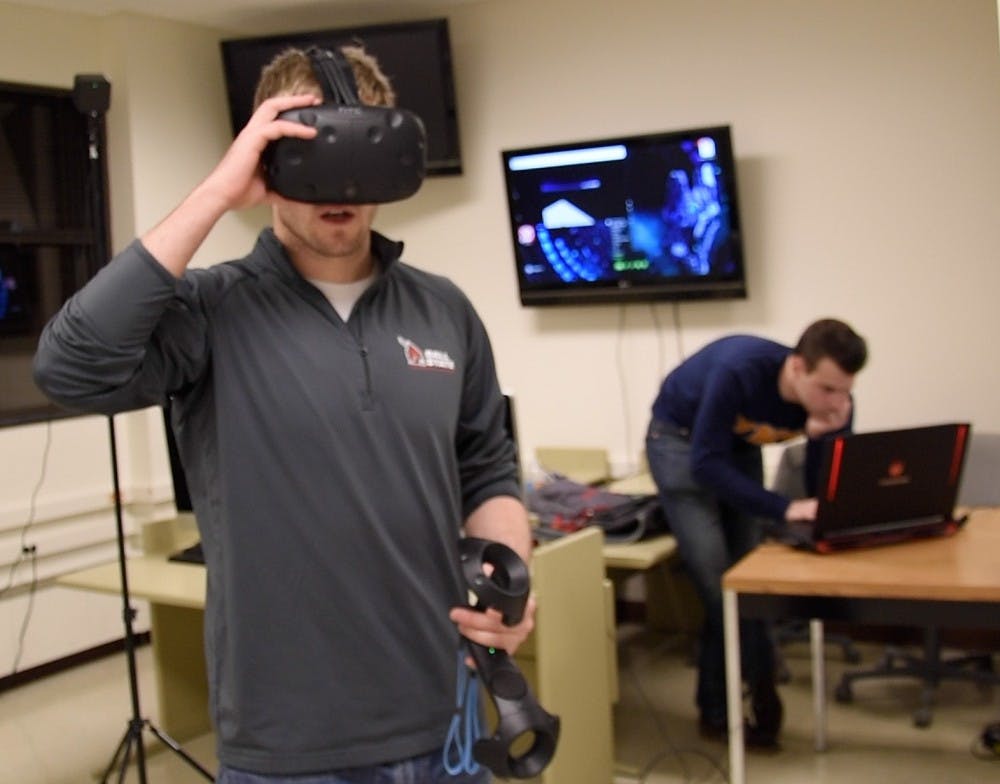Virtual reality has taken the world by storm. Canalys predicted in December 2016 that virtual reality headset sales worldwide exceeded two million last year and may grow to 20 million sales in the year 2020.
The first moment Bradley Ridge put on a virtual reality headset, he knew it was going to be big.
“I felt that little kid feeling, when you go to a big city for the first time and you’re just surrounded by awe and wonder," Ridge said.
Ridge, a senior computer science major, created an independent study centered around virtual reality after experiencing it at his internship this past summer at Eli Lilly.
During his internship, he worked with the virtual reality team and used augmented reality hololens devices. But it wasn’t until his roommate bought an HTC Vive system that Ridge realized what he wanted to do with virtual reality.
“From that point on I knew that this technology was going to change education and business altogether and I wanted to be a part of it, so I saved up for the last few months and I ended up purchasing an HTC Vive myself,” Ridge said.
The HTC Vive is the virtual reality system Ridge uses in his study. The Vive, priced around $800, and other virtual reality systems, like the Oculus Rift and Samsung Gear, are available to the public.
Virtual reality has taken the world by storm. Canalys predicted in December 2016 that virtual reality headset sales worldwide exceeded two million last year and may grow to 20 million sales in the year 2020.
Why is there such an explosion in popularity? Ridge chalks it up to a level of immersion virtual reality provides that screen-based interaction cannot. Not only can a user see a different world, but he or she can feel it and interact with it to the point that virtual reality is just that — a separate, real, digital world.
“Where instead you look at a screen and you kind of feel and you understand that that’s there and spatially what it is like, it’s completely different when you are in the world itself with that object,” Ridge said. “And what these allow you to do is essentially forget that they’re handheld controls and think you’re in the world itself.”
In his independent study, Ridge and his research assistants Isaac Walling and Spencer Kolbus, both junior computer science majors, sponsored by Paul Gestwicki, associate professor of computer science, aimed to show how virtual reality can not only be incorporated into education and business, but also enhance them.
"We are aiming to prove virtual reality not only belongs in education and business, but unlocks unprecedented potential," Ridge said. "Isaac Walling, Spencer Kolbus and I will be comparing learning experiences utilizing thee-dimensional content in both virtual reality and on two-dimensional devices like iPads or computers."
Ridge has already communicated with Lifeliqe, a software developer that creates education resources to be used on tablets and virtual reality systems in the classroom for K-12 STEM learning. The software makes learning immersive by placing a student next to a stegosaurus in the virtual world, where he or she can reach out and touch the dinosaur to identify the head, feet, tail and other parts of the body.
Another part of the independent study is an offer to demonstrate virtual reality to any departments, faculty or students who want to experience it.
Ridge has shown his virtual reality system to others before. Generally, there are three stages of being immersed that those new to the virtual world go through, he said.
“Initial reaction is they’re just shocked,” Ridge said. "They can’t believe that it’s quite as detailed as what they’re actually experiencing. The second phase, they kind of become aware of their surroundings in the virtual world, and the third and final phase is they actually forget that they’re surrounded by a real setting."
To get involved in the study or to request a virtual reality demonstration, please contact Bradley Ridge at ballstatevirtualreality@gmail.com.





